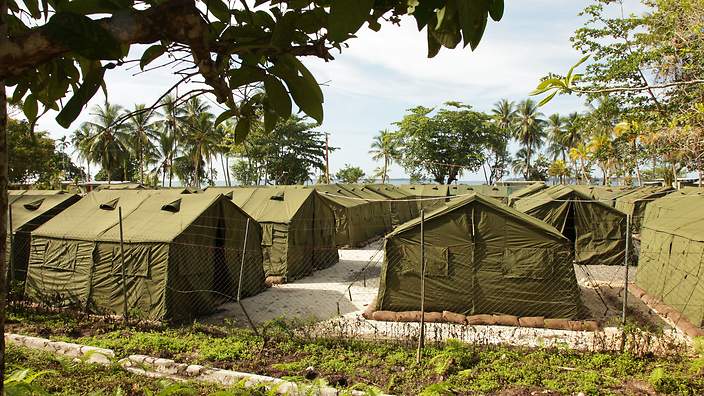Closing Manus Island’s Detention Centre
By Dr. Binoy Kampmark
29 April, 2016
Countercurrents.org

It was considered by the Australian Human Rights Commissioner Gillian Triggs to be inevitable and logical. The indefinite detention of 850 refugees and asylum seekers in the Manus Island Detention Centre, a large warehouse for humans seeking refuge from persecution, has been deemed illegal by the Papua New Guinea Supreme Court. Papua New Guinea’s Prime Minister, Peter O’Neill, has taken the next step in attempting to close down the processing centre.
An Australian Labor government created the centre, but those associated with it claim that it was not intended to be open for such a duration. The shibboleth of offshore refugee processing persists on both sides of the aisle in Canberra, making any direct criticism of the camp system incidental and irrelevant.
To expect a constructive response, to that end, would have been too much. Shadow immigration spokesman, Richard Marles, has thrown the rhetoric of saving human lives at sea back at the government. What will happen after the closure? Why aren’t Australian officials converging in desperation upon the facility to shore it up?
The reasons for an imminent closure are simple. Unlike Australia, the PNG constitution contains human rights provisions specific to liberties of the subject. The Australian High Court has proven reluctant to imply any such provisions, a situation which has permitted indefinite detention regimes to flourish.
In contrast, the PNG provisions speak against holding people on the basis of unlawful entry into the country, or lawful removal of a person from the country, or the process of fulfilling either purpose. Amendments passed in 2014 effectively qualifying this could only be “reasonably justifiable in a democratic society having a proper respect for the rights and dignity of mankind”. The Supreme Court remained unconvinced.
The decision has placed the fate of the detainees in an absurd state. The Immigration Minister Peter Dutton has decided to lob the issue back to PNG authorities, claiming that he had anticipated this move all along. (How such a keystone copper could have anticipated the deliberations of judges of a supreme court in another country is anybody’s guess.)
Having arranged to dump human cargo on Manus Island, with PNG connivance, the Australian federal government now insists that the 850 asylum seekers and refugees are their responsibility. “The Memorandum of Understanding is fairly clear, and that’s understood by both sides.”
The nature of this understanding entails that the detainees, once they are “found to be owed protection – that is, they’re found to be refugees – then they settle in PNG.” The monstrosity of expecting designated refugees to be settled in PNG has become something of a running joke.
As with all memorandums of understanding, what is understood differs depending on the party. The PNG High Commissioner to Australia, Charles Lepani, disagrees with Dutton’s dismissive approach, arguing that the Memorandum only extended to those refugees who decided to settle in the country. “Those who are found to be legal refugees, we invite them to stay in Papua New Guinea, to be part of our community but if they refuse, we cannot force them.”
Such sober observation was complemented by Labor MP Melissa Clarke’s observations that international law made Australia responsible for the human cargo it so unceremoniously dumped on PNG.
The resettlement program in PNG has hardly been a stellar success. Everything in it suggests a grizzly failure. In a sharp attack of Stockholm syndrome, some refugees have even wished to return to the camp centre after release. Yaser Afshar, for one, was sent to Lae to take up a carpentry apprenticeship. Feeling far more suited for a job in hospitality and catering services, but finding no support from the PNG authorities to pursue such an aim, he purchased a ticket to return to Manus. He has been refused readmission.
The hunt is thus on to find room at other centres. A rancid rumour is being fed through the channels that Nauru might receive some of the detainees. Dutton himself wishes to consider other options on Manus in what would amount to a reconversion. “I think there is an opportunity for the detention centre to remain in place in a different form, perhaps an open centre arrangement.” Such figures are slow to learn.
Christmas Island has been suggested, an option Dutton would rather not embrace. With characteristic moral myopia, the minister has suggested that doing so would encourage greater movement to Australia. “That would be a green light for people smugglers… you would have drownings at sea.”
Everything is stacked, in logic and principle, against the camp system. Far from being “misty-eyed” about such immigration policy, as Prime Minister Malcolm Turnbull has cautioned against, much well informed criticism about this anti-refugee leviathan is possible. In legal terms it has been found to be wanting as an affront to liberties. In terms of safety, the camps have been abysmal failures. In budgetary terms, the Australian Parliamentary Budget Office has argued that closing offshore detention centres would save the tax payer to around $2.47 billion over the 2015-6 budget.
Turnbull has decided to give the detainees no reassurance, insisting that they will not be resettled in Australia. The costly exercise of running such camps will continue, though the entire program risks, in the most necessary sense, imploding. This is image making of the worse sort, and respective Australian governments are bound to continue this sham in some form.
Dr. Binoy Kampmark was a Commonwealth Scholar at Selwyn College, Cambridge. He lectures at RMIT University, Melbourne. Email: [email protected]

